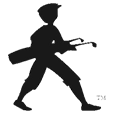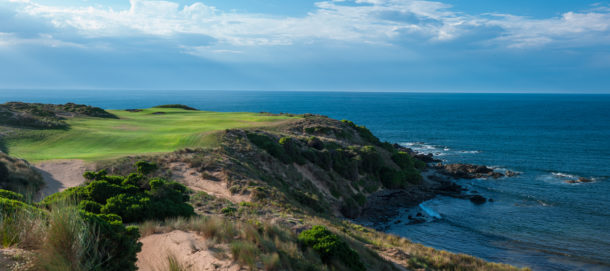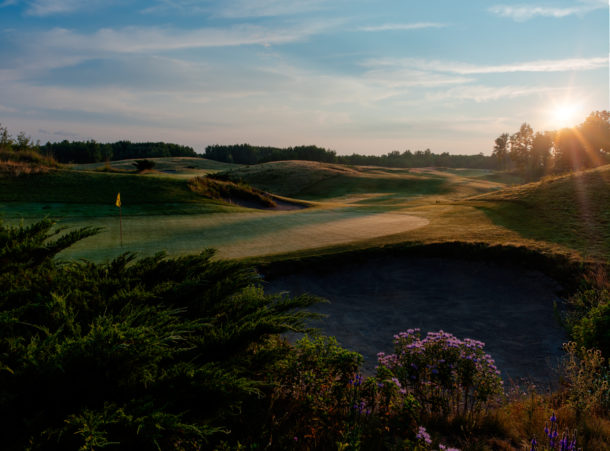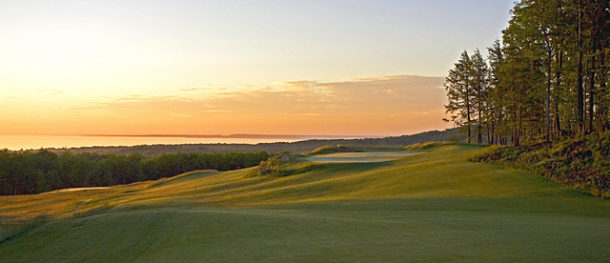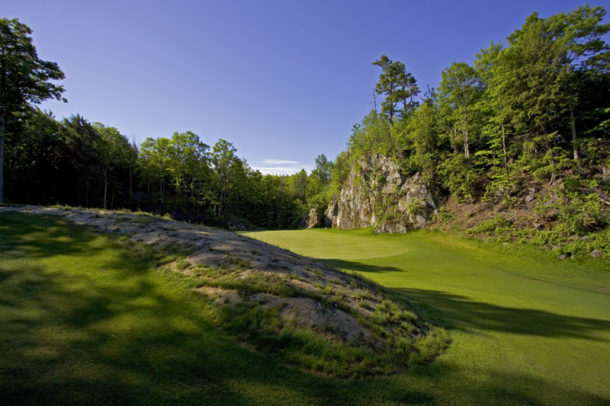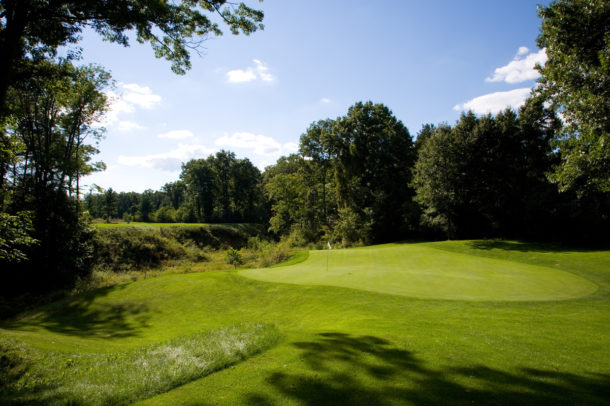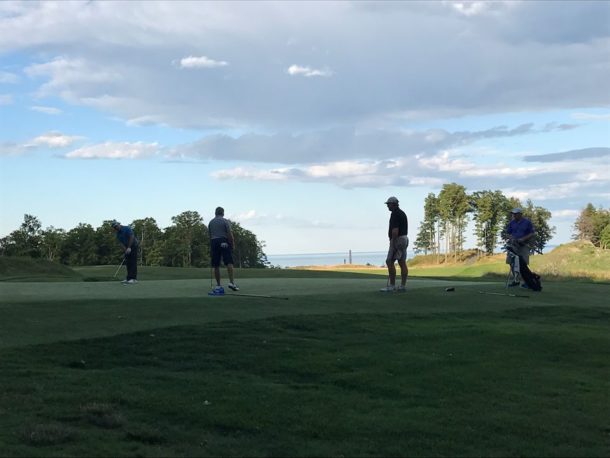The Society is pleased to have interviewed Golf Course Architect Mike DeVries for a Q & A. Mike hails out of Traverse City, Michigan and has designed 6 Golf courses worldwide, along with restorations and renovations to his credit. If you haven’t played one of Mike’s courses you need to plain and simple. Mike’s Cape Wickham in King Island, Australia is now ranked 24th in the World by Golf Digest in 2016/17. The Kingsley Club and Greywalls in Michigan rank highly in a state with a deep bench! Mike’s 3 SW Michigan courses (The Mines, Pilgrims Run, and Diamond Springs) are not to be missed in the Greater Grand Rapids area! His most noted Restoration work is The Meadow Club; which is Alister MacKenzie’s first North American course. Mike is highly energetic which carries over to his passion with the great game of golf. His career path is established, proven, and far from over! Well let’s get to the Q&A interview……..
TWG- Well Mike it’s great to interview you for the Walking Golfers Society. I’m a fan of your work and I have played all of your US Designs here in Pure Michigan (Go Bucks)! Can you tell us about your early days of playing Golf and whether or not you were Walking from an early age?
Well, my grandfather taught me the game at an early age and I started by whacking some sawed-down woods from the yard, trying to hit it over the road. When my grandparents and uncle played, I would follow them around the course. They were typically in a golf cart – the classic old 3-wheel cart with a tiller steering bar – and that was exciting to me, like most other young kids. I mean, here was a motorized vehicle that was more our size and every once in awhile, I was asked to move the cart, which was pretty exciting to do. I would chip and putt around the green, particularly where my uncle finished, since he was a really good player and I tried to mimic him.
When I was a little older, I played a little 9-hole course, where my mom or grandmother would drop me off and I would play as a single or get paired up with other kids, adults, or whoever was available. That was always a walking game, as it was a hilly little course, par 32. When I played on the golf team in high school, we always walked.
When I started working in the pro shop at 14, I got carts out and loaded bags for players onto the carts – almost everyone rode at that time. When we would go play after work, we took a cart and then went to pick the range afterwards. Throughout high school and college, when working at the course, I almost always took a cart because everyone did, except 4 guys in their 80’s – they always walked, at least the front nine. I guess you could say they knew what they were doing!
For the last 30 years, I have walked 90+% of the time. It is a much more enjoyable game and the cadence helps your rhythm and swing. It is more social and friendly. There are still outings where everyone rides and usually it’s a shotgun, so you need to get out to your hole. Other times, the course is broken up with long green to tee walks and it would add an unbelievable amount of time to the round, so I ride then.
TWG- Well we know that many courses designed from 1980-2008, weren’t too friendly for us walkers! Did you ever turn down a job due to the owner refusing a Walking Routing or even worse, banning walking? A mutual friend of ours refers to this as ‘’Routing 101 Malpractice’’.
No, I have never had that dictated to me but most owners do have carts on their course, so you need to accommodate for them in the planning and long range maintenance. All of my owners have been interested in having their course “walkable” because they understand that it makes for better golf and a better experience, even if someone is riding in a cart.
TWG- You have designed 5 courses in Michigan (Diamond Springs, Pilgrims Run, The Mines, Kingsley, and Greywalls) and what impressed me so much is that each design is very unique. You feel you are on a DeVries track but I think many golfers wouldn’t know if untold. My feeling is you had 5 unique properties and each site gave you more freedom to take chances. How do you see it?
Each and every site has its own unique features and sense of place. A good design brings out those qualities that say this is “X Golf Course” and make it special. Michigan has a lot of great terrain that is very applicable to good golf. It also has lots of good sandy soils that are great for growing quality turf. If you have good soils and nice contours, the key to creating a fun golf course is to bring out the qualities of the site and let the lay of the land give you interesting problems for golfers to solve. Certainly, there are areas where you have to move dirt and create features but first it is important to get as much out of the land as you can with what is inherent in the site.
TWG- I wanted to address Diamond Spring and it’s unique one cut design, with 60-yard-wide fairways and fine fescue Native rough. One could say it’s the poor man’s Augusta on Sand?.? The fairway contours lead to some nice speed slots. It has a few challenging walks but interesting land is the reward. Can you please tell us about this ‘’Field of Dreams” Golf Course in SW Michigan?
Kris Shumaker wanted to be able to mow the entire golf course with essentially two heights of cut: green and fairway. This gave him the opportunity to use big gang mowers to quickly mow the course with 2-3 people and would give golfers the ability to hit the ball just about anywhere, find it, hit it again, and play a fun round without looking for lost balls.
The angles of play make it advantageous to be in a particular position to score well but the average golfer can just move around quickly and have fun. This is essentially what the Old Course at St. Andrews does and it is a great concept that I try to employ when the land and program allows it.
Diamond Springs is a really great walk because the land is basically flat with a number of long eskers that go across the property. These broad ridges are used for tees, greens, as obstacles to drive over or around, and provide great character to the golf course without making for excessive “hill-climbing.” Then on the NE section of the course is an old ravine that intersects or abuts holes 9 and 14-18 – these “gorge” holes are very dramatic and strategic in how aggressive you want to play your shots, so it heightens the intensity for the golfers and gives them a crescendo at the end of the nines. There is a little walk-back from 14 green to 15 tee, but if you know the course and it is not busy, you can play your tee shot on 15 before going to the 14th green and that saves time. Besides that, the course is really a great walk.
TWG- With many Golden Age designs being neutered over the last century with quite possibly their boldest features being removed by club boards, do you think that has led to a resurgence of quirk in the modern era? Do you think there are Good examples of Quirk and Poor ones?
Quirk is in the eye of the beholder, isn’t it? One person’s quirk is another’s bad golf, so it is hard to say you can put it in, without it feeling forced. I think you make decisions at to what is acceptable, depending on what it would cost to “fix” something or make it more middle of the road.
For instance, at Greywalls, I had to get from the low area of holes 2-4 up to the 5th, 6th, and middle plateau holes – in order to make that happen, the 5th hole has a severe uphill drive. The green site is very dramatic and unique but the landing area was tight, so we had to blast a section of the left side to make it more playable for the average player. The hole is a short 4, so a drive doesn’t have to be big but it is possible for the big hitter to go for the green, which is blind from the tee. The “quirk” and challenge of the drive might be more to the negative but is offset by the very dramatic green site between rock outcroppings and a vertical wall (“positive quirk?”). Subsequently, it is one of the more memorable holes on the course.
TWG- You have built some edgy greens such as #14 at Diamond Springs, #7 at Greywalls, and #13 & 17 at Kingsley. Do you think the golfers prefer them to your subtle greens such as #18 at Greywalls?
Usually, those more severe greens are dictated by their sites and I try to balance them with softer, more subtle greens to create balance and variety throughout a course. So, overall, I am not sure golfers like certain types more than others but enjoy the differences in them on the course, as long as there is balance.
#7 at Greywalls is an interesting choice, as it has some very big movements in it but is also very subtle in its deception, since the severe downhill nature of the land still controls many of the slopes but, optically, it looks like the ball will be going uphill or break the other way. It is a wonderful green and is one of those where local knowledge helps out considerably.
TWG- Do you feel you have benefited with your Landscape Architecture degree in the Golf design business? Would you recommend a young guy pursuing a Golf design career to spend time in the studio, on a Construction site, or something else?
Yes, my schooling was very helpful and really provides the big picture on lots of design and planning concepts. Understanding the game of golf and how it is played by all kinds of golfers is also important (and that doesn’t necessarily mean you have to be a great, or pro, golfer to “get” that). Getting around and seeing/playing the great courses of the world shows you what works and why, as well as exposes you to many different environments for golf. Getting experience on a greens maintenance crew and a golf course construction crew gives immeasurable insight into how to build and maintain a course. Those experiences and many others provide for lots to draw on when designing a new course or working on a classic design.
TWG- Over Dinner last summer we had a great conversation about Millennial golfers and I was impressed with your response. You didn’t feel that we should cater to them and that we should instead teach them proper etiquette and form. Amen! How do we explain to them and others that walking on the Golf course can save them money on a Gym membership and increase their enjoyment on the course at the same time?
It is hard to convince them of many things that don’t involve using a cell phone or having it handy almost all the time. Golf, as an industry, has done a poor job of explaining what is great about this sport: you walk and get exercise that way, you communicate directly with your playing companions in conversation, you have the opportunity to put away and get away from the stress of always being “connected” with everyone else, you learn respect for your fellow man by being quiet when they hit, and you learn to do the right thing by calling a penalty on yourself when no one sees it happen but you. Golf is a unique and very difficult sport but those elements above reveal the true spirit of the game. The golf industry needs to start promoting what is special about our game and that will attract people.
Another great aspect of golf is that it is a way to bridge generations and share something together. I learned from my grandparents and uncle early on. Golf was not easy and I didn’t love it every time but it taught manners and respect while also giving lots of highs with those (rare) pure shots.
Walking the course is actually quite quick if you all go to your ball and play ready golf – I’ve walked a “tougher than average to walk” course as a threesome in 2 ½ hours. And you can choose to play only 9 holes if time is a factor.
TWG- You have built world renowned Cape Wickham in Australia and I’m sure have spent a good bit of time in the Land Down Under, I’m Jealous. The culture there is much different I hear. Do you see more of our 2nd and 3rd tier private courses adopting an Aussie model of 700-1000 Golf members at a smaller fee? We are slowly starting to see more clubs in the US embracing Trolleys, hopefully it continues.
American golf versus golf in the UK, Ireland, or Australia is quite different. I am seeing more golfers walking, for exercise and the enjoyment of the game, but it is not anywhere near the walking mode of golfers in the rest of the world. Certainly, I think the more health conscious younger generations see that as a benefit but many of them also just take a cart 90% of the time. Courses should encourage walking by not always including the cart fee in with the greens fee.
It would be interesting if an American club would follow the larger membership – smaller fees of an overseas club but it would probably need the right developer/location to make it really work the way it does elsewhere.
Trolleys, caddies, and carrying your own bag are becoming more common in America once again but carts still rule most courses. The recent (last 20 years) interest in playing hickory-shafted clubs has also spurred traditional golf approaches to the game. Regular golfers see that and become interested, asking questions, and maybe even trying hickories. Hey, maybe there is hope that golf will return more to its roots and walkers will prevail over carts?!?
Thanks for having me and Keep Walking!
TWG- Thank You and Amen!
